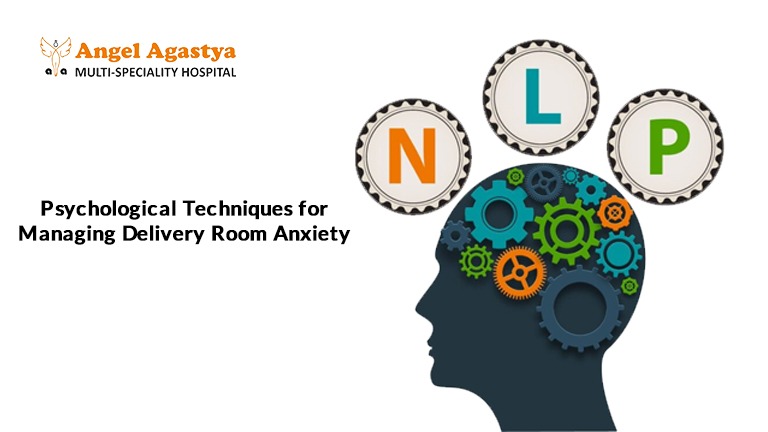Easy Ways to Feel Good in the Delivery Room
Anxious about labour? You’re not alone, and you’re not overreacting. Stress hormones can impact labour, but they’re not the boss.
With science-backed tools like NLP and affirmations, relief is possible. Let’s prepare your mind as beautifully as your body.

Introduction
The journey towards welcoming a new life into the world is one of the most beautiful yet intense experiences a woman goes through. In India, where motherhood is celebrated as sacred, the emotions tied to labour and birth are deep-rooted. However, along with excitement, many expectant mothers also carry a hidden companion “Delivery Room Anxiety”.
This anxiety, often felt in the pit of the stomach or hidden behind a brave smile, is natural. After all, labour is unpredictable and powerful. But if this fear remains unchecked, it can disturb the natural flow of labour, amplify pain and take away from the joy of the birthing experience.
Fortunately, just as a skilled yogi trains the mind to attain calmness, a pregnant woman, too can learn techniques to calm her inner storm. In this blog, based on the wisdom of seasoned Indian gynecologists, we shall explore how simple yet powerful psychological techniques like Neuro-Linguistic Programming (NLP), visualization and affirmations can help manage delivery room anxiety and foster a more joyful birthing journey.
Understanding Delivery Room Anxiety: Causes and Effects
Before we dive into techniques, it’s important to first understand why delivery room anxiety happens. Knowing the reasons behind it can help moms-to-be and their families approach labour with more calm and confidence.

Common Causes of Delivery Room Anxiety:
Fear of Pain: Labour pain is often shown in movies and TV shows as unbearable. Naturally, many women start fearing the intensity of pain even before their due date arrives. This fear alone can trigger serious delivery room anxiety. but dont worry there are several options available which reduce the labour pain. ex. – epidural (painless normal delivery)
Fear of the Unknown: No one can predict exactly how labour will unfold. Will it be short or long? Smooth or complicated? This uncertainty often causes anxiety, especially for first-time mothers.
Concern for the Baby: Every mother’s heart is deeply tied to her baby’s safety. Worries about the baby’s well-being, even when everything seems fine, can make anxiety levels spike during labour.
Past Negative Experiences: If a mother had a difficult or traumatic birth earlier, memories of that experience can return in full force, leading to strong feelings of anxiety.
Influence of Movies and Stories: Indian TV serials, Bollywood movies and even neighborhood aunties love to share dramatic birth stories. These exaggerated accounts, though often intended to entertain or warn, frequently contribute to unnecessary fear.
Family and Societal Pressure: In many Indian families, there are high expectations about how labour “should” happen. Pressure to have a “normal delivery” or avoid certain medical interventions can unknowingly add to a mother’s anxiety.
Feeling of Losing Control: Labour can sometimes feel like an overwhelming force, something happening to you rather than something you are doing. This loss of control fuels anxiety.
Effects of Delivery Room Anxiety on Labour:
Physical Effects: Anxiety releases stress hormones like adrenaline, which tighten the muscles and slow down the release of oxytocin; the “love hormone” that makes contractions effective and labour smoother.
Increased Pain Perception: When you are anxious, your body tenses up. This muscle tightness actually makes labour pain feel worse, creating a cycle of fear, tension and more pain.
Difficulty Coping: High anxiety makes it harder to concentrate on helpful tools like breathing exercises, visualization, or meditation, making labour feel more overwhelming.
Negative Birth Experience: Strong delivery room anxiety can lead to feelings of helplessness or sadness afterward. It may even delay emotional recovery and bonding with the baby.
Recognizing these causes allows us to tackle anxiety at its roots.
Psychological Techniques for Managing Delivery Room Anxiety
Indian traditional wisdom says, “The mind itself is the cause of bondage and liberation.” Thus, calming the mind during labour can completely transform your birthing experience. Facing delivery room anxiety is not a sign of weakness; rather, it is a sign that you care deeply about your baby. Let’s explore three simple and effective psychological techniques that can help manage delivery room anxiety beautifully:

Neuro-Linguistic Programming (NLP) for Positive Birthing
What is NLP?
In simple words, NLP (Neuro-Linguistic Programming) teaches us how to change the way we think and talk to ourselves. By using positive words and images, we can shift our emotions from fear to calmness even during labour.
How NLP Can Help During Labour:
- Anchoring: During your pregnancy, practice a small gesture like pressing two fingers together every time you feel peaceful. Later, in the delivery room, doing the same gesture can instantly bring back that feeling of calmness when anxiety starts to rise.
- Reframing: Change the way you view contractions. Instead of thinking, “Contractions are painful,” think, “Every contraction is bringing my baby closer into my arms.” This simple shift can reduce delivery room anxiety and fill you with positive energy.
- Sensory Acuity: Focus your senses on calming things like the warmth of your partner’s hand, your doctor’s reassuring words, or soft music in the background. Engaging your senses helps anchor you to the present and keeps fear away.
- Building Rapport: Trust and open communication with your gynecologist, nurses and birth partner are essential. When you know your team is supporting you, it will naturally reduce anxiety.
While formal research on NLP in childbirth is still growing, many women who have used these techniques say they felt stronger, calmer and more in control during labour.
Visualization for a Calm and Confident Birth
What is Visualization?
Visualization simply means creating positive images in your mind. Just like farmers in olden times imagined a rich harvest before sowing seeds, mothers-to-be can imagine a smooth, peaceful birth.
Simple Visualization Techniques for Labour:
- Imagine Smooth Labour: Close your eyes and picture your cervix opening gently, like the petals of a lotus flower which is soft, natural and easy.
- Create a Safe Space: Visualize the delivery room as a sacred, peaceful place where every person is there to honor, respect and support you.
- Focus on Baby’s Journey: Imagine your baby moving gently and safely through the birth canal, helped by each wave of contraction.
- Contractions as Gentle Waves: Instead of seeing contractions as painful, imagine them as waves of the ocean that are strong but manageable, helping your baby move closer to you.
Modern science supports that visualization can lower stress and anxiety during childbirth. In traditional Indian practices too, pregnant women were always encouraged to focus their minds positively during labour to create a healthy, happy birth experience.
Affirmations for Positive Birthing Beliefs
What are Affirmations?
Affirmations are positive sentences repeated to oneself to counter fear and build confidence. Just like a lamp dispels darkness, positive words dispel fear.

Affirmations for Labour:
- Strength and Resilience: My body is strong and my strength is limitless.
- Trust in the Process: I trust my body and the natural process of birth.
- Managing Sensations: Each contraction brings me closer to my baby.
- Baby’s Well-being: My baby is safe and healthy.
- Calm and Peace: I am calm and centered.
- Partnership: My partner and I are a strong team.
How to Use Affirmations:
- Write them on sticky notes around your home.
- Speak them aloud during your daily walks.
- Combine them with deep breathing.
- Whisper them during early labour.
Psychological studies confirm that affirmations can rewire the brain for positivity. Many Indian gynecologists now encourage moms-to-be to practice them daily.
Integrating NLP, Visualization and Affirmations for a Holistic Approach
Imagine three powerful rivers, say NLP, visualization and affirmations are merging together to form a mighty Ganga. Each one is strong on its own, but when they come together, they create a powerful force that can help you overcome delivery room anxiety with ease.

Here’s how you can blend them beautifully during pregnancy and labour:
- Anchor a Calming Affirmation: Choose a simple, positive affirmation like “I am safe, I am strong.” Now, connect it to a small hand gesture, like pressing your fingers together. Every time you do the gesture, say the affirmation in your mind. This way, during labour, the gesture alone can instantly bring a sense of calm and strength.
- Visualize a Peaceful Birth While Repeating Affirmations: While resting or meditating, close your eyes and picture a smooth, gentle birth. See yourself surrounded by loving support. As you visualize, softly repeat your affirmation. This practice will train your mind to stay positive and grounded even when contractions start.
- Reframe Doubts into Strength: Whenever a moment of fear or doubt creeps in, gently reframe it. Instead of thinking, “What if I can’t do this?”, shift it to, “I am ready. My body knows what to do.”
Practicing these techniques regularly during pregnancy helps them become second nature. When you finally enter the delivery room, your mind and body will already know how to respond to the moment with calmness, strength and trust. This simple switch strengthens your inner confidence and eases delivery room anxiety.
The Role of Support and Preparation
Even the most empowered mind blooms better with support.
- Birth Partner Support: A caring partner can hold your hand, encourage your breathing and remind you of your affirmations when you forget.
- Childbirth Education: Attending antenatal classes demystifies labour, offers breathing techniques and builds realistic confidence.
- Birth Plan Preparation: Writing a birth plan helps communicate your wishes to the medical team and gives you a sense of control.
In India, where families are closely knit, encouraging close relatives to be informed and supportive can make a huge difference.
Conclusion
Delivery room anxiety may visit your mind, but it does not define your strength. Feeling nervous shows how much you care, but you are bigger than your fear.
With the power of NLP, visualization and affirmations, you can take charge of your birth experience with a calm mind, a strong spirit and a heart full of purpose.
Dear mothers-to-be, trust the incredible power within you. Your body is wise, your mind is strong and your journey into motherhood is a celebration of life. Let your strength shine through every moment.
If at any point your anxiety feels heavy or you sense something unusual, make sure to speak to your gynecologist. A little guidance can bring great comfort and safety.
Frequently Asked Questions (FAQs)
1. Is it normal to feel delivery room anxiety even if I have prepared for childbirth?
Yes, preparation reduces anxiety but does not eliminate natural emotions. The goal is not to eliminate fear entirely, but to make emotions manageable and healthy.
2. How early in pregnancy should I start practicing visualization and affirmations?
Ideally, start in the second trimester and continue daily till labour. Consistency strengthens the mind-body connection.
3. Can I practice NLP techniques on my own or do I need a trainer?
Basic NLP techniques like anchoring and reframing can be self-taught through books or classes. For deeper mastery, a trained practitioner can help.
4. How do I remember my affirmations during intense labour?
Make them a habit now. Also, your birth partner can softly remind you or read them aloud during labour.
5. What if my labour doesn’t go as per my visualization?
Visualization prepares you mentally for a positive mindset, not a fixed script. A flexible, peaceful attitude helps handle surprises better.
6. Can delivery room anxiety affect my baby’s health?
Excessive stress can sometimes influence labour progress but rest assured, doctors constantly monitor the baby’s well-being. Managing your emotions helps both of you.
7. Are there any Indian traditions that support managing delivery room anxiety?
Yes! Practices like reciting slokas, focusing on mantras and guided breathing (similar to pranayama) have always been part of our heritage.
8. Should I inform my doctor about my delivery room anxiety?
Definitely. A compassionate gynecologist can guide you better, reassure you and sometimes even adjust birthing practices to support you.
9. Is delivery room anxiety higher for first-time mothers?
Usually yes, because of unfamiliarity. But even experienced mothers may feel anxiety. It’s individual and valid for everyone.
10. Can these psychological techniques help in cesarean births too?
Absolutely. Managing your mind helps even in planned or emergency cesareans by keeping you calm, focused and emotionally strong.

